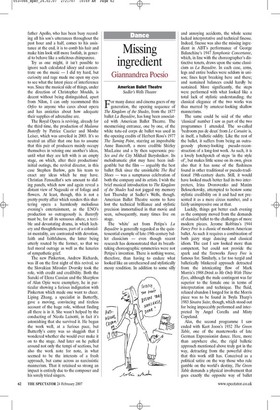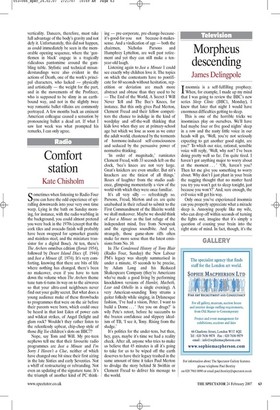Missing ingredient
Giannandrea Poesio American Ballet Theatre Sadler's Wells Theatre El or many dance and cinema goers of my generation, the opening sequence of The Kingdom of the Shades, from the 1877 ballet La Bayadere, has long been associated with American Ballet Theatre. The mesmerising entrance, one by one, of the white tutu-ed corps de ballet was used in the opening credits of Herbert Ross's 1977 The Turning Point, starring an improbable Anne Bancroft, a more credible Shirley MacLaine and a by then supersonic preSex and the City Mikhail Baryshnikov. Its melodramatic plot may have been indigestible but the film — arguably the best ballet flick since the unsinkable The Red Shoes — was a sumptuous celebration of both the company and its artists. I wish the brief musical introduction to The Kingdom of the Shades had not jogged my memory last Thursday at Sadler's Wells, though. American Ballet Theatre seems to have lost the technical brilliance and stylistic precision immortalised in that movie and seen, subsequently, many times live on stage.
The 'white' act from Petipa's La Bayadere is generally regarded as the quintessential example of late-19th-century ballet classicism — even though recent research has demonstrated that its breathtaking choreographic symmetries were not Petipa's invention. There is nothing worse, therefore, than having to endure what looked like an unrehearsed and stylistically messy rendition. In addition to some silly and annoying accidents, the whole scene lacked interpretative and technical finesse. Indeed, finesse was also the missing ingredient in ABT's performance of George Balanchine's 1947 Symphonic Concertante, which, in line with the choreographer's distinctive tenets, draws upon the same classicism as La Bayadere. In each case, arms, legs and entire bodies were seldom in unison; lines kept breaking here and there; and sustained balances could hardly be sustained. More significantly, the steps were performed with what looked like a total lack of stylistic understanding; the classical elegance of the two works was thus marred by amateur-looking shallow mannerisms.
The same could be said of the other 'classical' number I saw as part of the two programmes I attended. The so-called 'bedroom pas de deux' from Le Corsaire is, in itself, a balletic oddity. Like the rest of the ballet, it suffers from being an outrageously phoney-looking pseudo-reconstruction of a long-lost work. As such, it is a lovely hotchpotch of steps 'in the style of', but makes little sense on its own, given also that it has none of the flashiness found in other traditional or pseudo-traditional 19th-century duets. Still, it would have looked much better had its two interpreters, IrMa Dvorovenko and Maxim Beloserkovsky, attempted to bestow some stylistic credibility on it and had not presented it as a mere circus number, and a fairly unimpressive one at that.
Luckily, things got better each evening as the company moved from the demands of classical ballet to the challenges of more modern pieces. Jerome Robbins's 1944 Fancy Free is a classic of modern American ballet. As such it requires a combination of both jazzy stage dancing and classical idiom. The cast I saw looked more than competent, but could not provide the spark and the fireworks Fancy Free is famous for. Similarly, a far too turgid and balletically blinkered approach detracted from the intoxicating flow of Mark Morris's 1988 Drink to Me Only With Thine Eyes, although the male contingent was far superior to the female one in terms of interpretation and technique. The fluid, relaxed abandon I longed for in the Morris piece was to be found in Twyla Tharp's 1983 Sinatra Suite, though, which stood out for being impeccably performed and interpreted by Angel Corella and Misty Copeland.
Alas, the second programme I saw ended with Kurt Jooss's 1932 The Green Table, one of the masterworks of late German Expressionist dance. Here, more than anywhere else, the rigid balletic approach mentioned above truly got in the way, detracting from the powerful drive that this work still has. Conceived as a political satire on the way those who rule gamble on the world's destiny, The Green Table demands a physical involvement that goes exactly the opposite way of ballet verticality. Dancers, therefore, must take full advantage of the body's gravity and not defy it. Unfortunately, this did not happen, as could immediately be seen in the memorable opening sequence, where the 'gentlemen in black' engage in a tragically ridiculous pantomime around the gambling table. Stylistic and technical misunderstandings were also evident in the actions of Death, one of the work's principal characters, who lacked — physically and artistically — the weight for the part, and in the movements of the Profiteer, who is supposed to be slimy in an earthbound way, and not in the slightly twee way romantic ballet villains are commonly portrayed. A few months back an eminent American colleague caused a sensation by pronouncing ballet a dead art. If what I saw last week was what prompted his remarks, I can only agree.























































 Previous page
Previous page